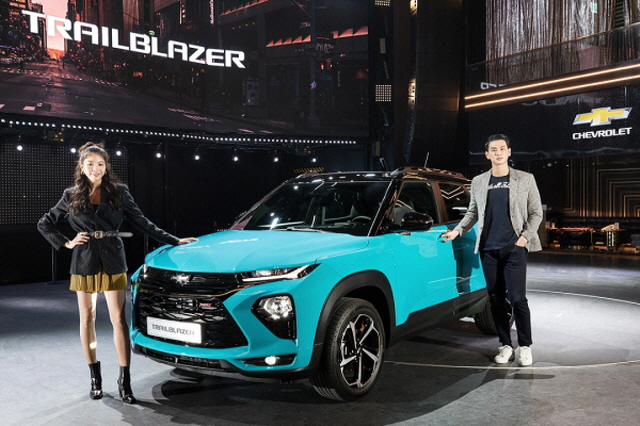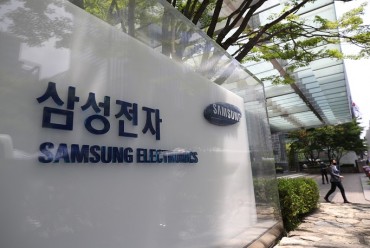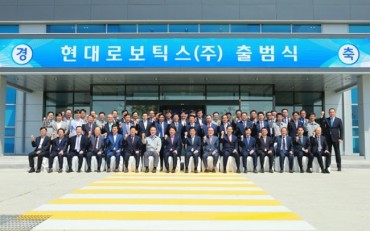
This photo, provided by GM Korea on Jan. 16, 2020, shows models posing at the local launch ceremony of GM’s Trailblazer SUV in Incheon, west of Seoul.
SEOUL, Jan. 16 (Korea Bizwire) — GM Korea Co., the South Korean unit of General Motors Co., on Thursday launched the Trailblazer SUV as it strives to revive sales amid labor woes and weak demand.
In the past two years, GM Korea has played a leading role in developing the Trailblazer as the Chevrolet brand’s “core next-generation model, the company said in a statement.
With the addition of the Trailblazer, SUVs and recreational vehicles account for 60 percent of the company’s Chevrolet lineup.
It plans to increase the ratio to 70 percent to meet a rising demand for SUVs, GM Korea President and Chief Executive Kaher Kazem said in the new model’s launching event held in Incheon, just west of Seoul.
The Trailblazer comes in two versions — a front-wheel drive version with a 1.2-liter gasoline e-turbo engine and a continuously variable transmission (CVT), and another with a 1.35-liter gasoline e-turbo engine, the statement said.
The e-turbo features an electric motor-generator mounted to the shaft connecting the turbo’s compressor wheel and turbine.
The 1.35 gasoline model is equipped with an all-wheel drive powertrain and a nine-speed automatic transmission or with a front-wheel drive powertrain and a CVT, it said.
The Trailblazer is priced at 20 million won to 26 million won (US$17,000-$22,000), it said.
For a turnaround in sales, GM Korea launched the Equinox SUV in 2018 and the midsize Colorado pickup truck and Traverse SUV last year. But the U.S.-made vehicles didn’t help buoy sales.
For the whole of 2019, its sales fell 9.9 percent to 417,226 vehicles from 462,871 units a year earlier. It posted a net loss of 859 billion won in 2018 after reporting 3.13 trillion won in accumulated net losses in the 2014-2017 period.
This year, weak demand for its vehicles and possible strikes involving the unfinished wage deal for the year of 2019 still remain major concerns for GM Korea.
The company and its new labor union plan to start wage negotiations in March said union spokesman Kim Sung-gap who also attended the event.
“We want the company not only to focus on improving profitability but also on becoming a ‘responsible player in the community’ for win-win synergies,” Kim said.
In October, the former union leadership declared an end to negotiations with the company for the remainder of 2019 due to differences over wages.
The 10,000-member union demanded a 5.7 percent hike in basic monthly salary, one and a half months of wages in performance-based pay and a cash bonus worth 6.5 million won per worker.
But the company rejected the demands, saying the business environment is worsening and the company is still mired in a deficit. Partial and general strikes held last year resulted in production losses of 20,000 vehicles.
To jump-start sales, the company plans to introduce 15 new vehicles in the local market for the five years through 2023.
GM Korea’s Chevrolet lineup is composed of the Spark, Malibu and Impala sedans; the Trax, Equinox and Traverse SUVs; the Colorado pickup; the Camaro sports car; and the Bolt all-electric vehicle.
The Bolt, Impala, Equinox, Camaro and Colorado are from the United States, and the Malibu sedan, Trax compact SUV and Spark, Damas and Labo minicars are made locally.
The Trailblazer sits between the Trax and the Equinox.
In May 2018, GM and the state-run Korea Development Bank (KDB) signed a binding agreement that will permit a combined 7.7 trillion-won lifeline — 6.9 trillion won from GM and 810 billion won from KDB — to keep the Korean unit afloat. GM owns a 77 percent stake in GM Korea.
Under the deal, GM is banned from selling any of its stake in GM Korea before 2023 and is required to keep its holding in the unit above 35 percent until 2028.
(Yonhap)






